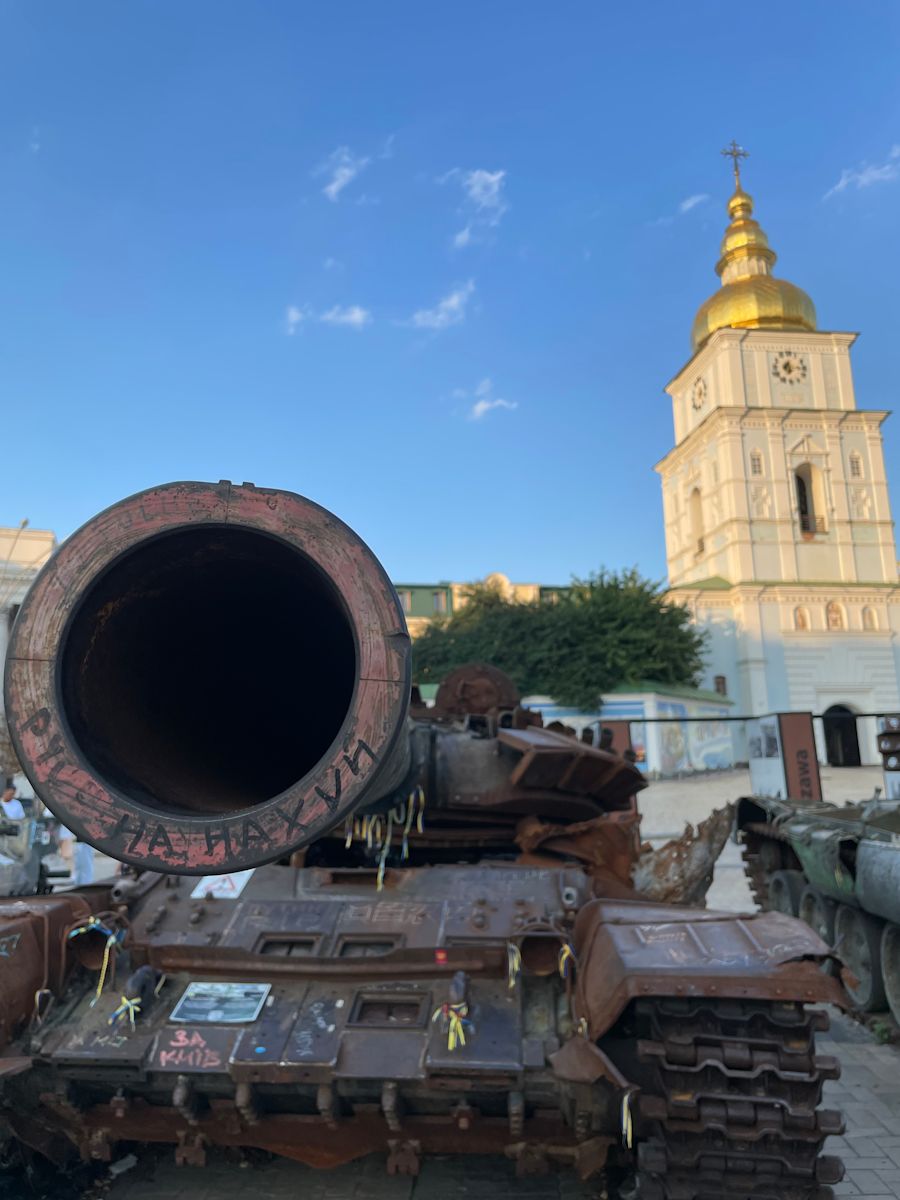One month in Ukraine: a field report from a country at war
One month ago, I left Berlin to volunteer in Ukraine – for the third time since the full-scale invasion began in February 2022. What is it like to be in Ukraine? How do Ukrainians cope with the war? What can we do to help defeat Russia?
Introductory remarks
“It is impossible to explain what was going on when the war broke out. I can try to describe it; but these are only words. You must have felt it, you must have experienced it to understand,” tells a woman in Kharkiv, let’s call her Larysa (all names changed). “In the morning of 24 February, we lost everything. Up until then, we lived a normal life with our families, our children, our jobs… But this morning, we woke up, heard the siren in our city, heard the bombing and saw the smoke on the horizon. In the streets, I noticed people running and trying to escape – often with their cats and dogs. Some searched for food. It was a complete chaos. There was no logic anymore.”
During the last weeks, we have not seen the same chaos, have not felt the same fear, have not experienced the uncertainty of the first days of the full-scale invasion. But even I have difficulties explaining to my friends back home in Germany what I have felt throughout the last month in Ukraine, a country at war. When I returned from volunteering in Ukraine in August 2022 and February 2023, I intended to write about my experiences. I did not. I had no idea where to begin and where to end. I have the same feeling right now, but I give it a try.
It is impossible for me to name my main “finding”, develop one coherent argument let alone making this into anything close to an academic article or just provide a comprehensive description of my experiences. Instead, I would like to recount a couple of moments in three cities: Lviv, Kyiv, and Kharkiv. I try to explain why these moments struck me. I came to help – to weave camouflage nets in Lviv, to clear the debris in private homes destroyed by Russians in Irpin and its surroundings, to renovate a classroom in Bucha, to produce camouflage clothing for snipers in Kyiv, and to cook in a field kitchen in Kharkiv. I left Ukraine with multiple encounters in my heart that I will never forget – and with profound humility when thinking of the Ukrainian people, their courage and their energy.
But these are just “fine words”. So, let me try to recall some experiences that – hopefully – fill these words with more substance and make them more comprehensible.
First stop: Lviv
Lviv is a city of 700,000 inhabitants in Western Ukraine hosting roughly 250,000 internally displaced persons according to the United Nations. The city is close to the Polish border. Karl Schlögel, an excellent expert of Eastern European history, once compared Lviv to an onion. When approaching the city from the outskirts to its city center, you pass through several “onion rings”, each of which reflects a distinct period in Lviv’s turbulent history: the prefabricated blogs of the Soviet times, the historicism of the Austrian empire, and the old town of the Polish period. For centuries, Lviv was home to almost equal numbers of Polish, Jewish and Ukrainian residents. Lviv has seen periods of successful integration when different cultures enriched each other and made the city one of the most innovative intellectual centers of the continent. But Lviv has also been the scene of brutal ethnic pogroms. While Lviv has always been a melting pot of cultures, religions, and traditions it is – ironically – treated as a germ cell of Ukraine culture and the Ukrainian language today.
Is it possible to be happy during the war?
The first impression of Lviv is deeply irritating when we arrive for the first time in August 2022. Russia had launched its full-scale invasion only six months before. But Lviv appears to us as the most cheerful and happy place of earth. It is a warm and sunny summer. Lviv is full of people that seem to enjoy life. They sit in cafés, in restaurants and bars. They take countless pictures of themselves in front of Lviv’s stunning architecture. At first, I ask myself how all these people can ignore the war, how they can party and why they are so narcissistic that they seem to be taking endless selfies.
The lively streets of Lviv (click to open)
Download
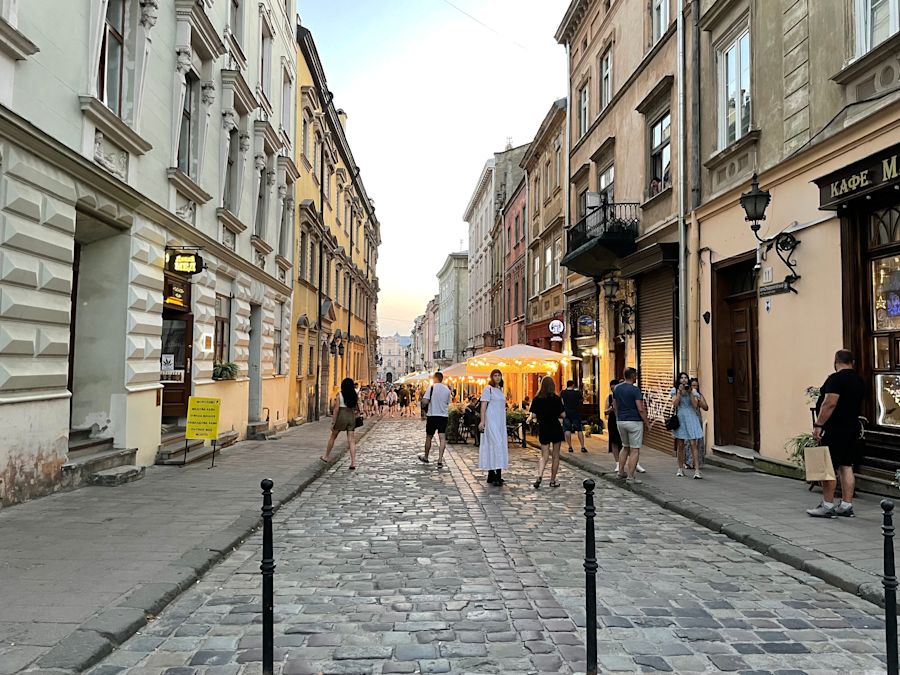
August 2023 looks pretty much the same. But I have learned to see behind the curtain. Many families temporarily reunite in Lviv. Soldiers get a few days of vacations from the frontlines visiting their families that are either internally displaced persons or refugees living in the European Union and visiting Lviv for a few days. These families try to leave the hardships of the daily routines of the war behind them for a few hours. The soldiers and their families yearn for a couple of “normal” days – when they are not at the front and when they are not refugees separated from their loved ones.
A closer look, though, reveals how difficult it is to fade out from the war. Some of the soldiers are visibly injured, many others appear somewhat absent – and one can only surmise the traumatic experiences that they are living through. In fact, Lviv and its surroundings has numerous recreational clinics that treat soldiers physically and psychologically. And all of a sudden, the endless amount of selfies that Ukrainians take in the streets of Lviv appears not necessarily as yet another case of the widespread narcissism that we witness in front of almost every landmark from the Athenian Acropolis to Berlin’s Brandenburger Tor to New York’s Statue of Liberty: After all, who knows how often these pictures will be opened by soldiers on the frontlines when they think of their beloved ones?!
On our last day, we visit a church in the old town of Lviv when, suddenly, Maria, a young woman that we met half a year before in the volunteer center where we weave camouflage nets, greets us gleefully. We are happy to meet again, ask how she has improved on her piano playing since last we met because she used to practice in the volunteer center when we were in Lviv in February. She has not improved much, she tells us, but she is still practicing. She laughs. “So, it seems you are doing fine…”, I notice casually. “No, not really,” she replies, and her eyes turn sad within the fraction of a second. “My brother got missing at the frontlines in March.” The world seems to stand still for a moment. Is he still alive? A few minutes later, Maria heads out to a military hospital where she volunteers. “When I talk to the soldiers, I forget my own sorrows and concerns,” she tells us.
The normality of the life on the streets of Lviv is an illusion.
Domestic refugees on the fence
In the city center, we find an inconspicuous sign that reads “Volunteer Center” in Cyrillic letters. We enter. To our left, a group of women cuts fabric into small stripes. In the back, a man in his thirties with minor spastic disorders sits in front of a computer and writes poems – day-in, day-out for the last one and a half years. If he is not talking to us with the brightest smile you can imagine, he is immersing himself in his poems that have only one subject: the war, the sacrifices of the Ukrainian heroes and the desire for peace. This is the dedication of a poet to the cause of Ukrainian freedom.
On the first floor, we find nets the size of several square meters stretched over shelves and other items that allow weaving into the nets the fabric stripes that are cut downstairs and make them into camouflage nets. A group of women works here every day as volunteers. The camouflage nets help the military hide roadblocks and equipment.
A camouflage net in the volunteer center of Lviv - ready to be delivered to the frontlines (click to open)
Download
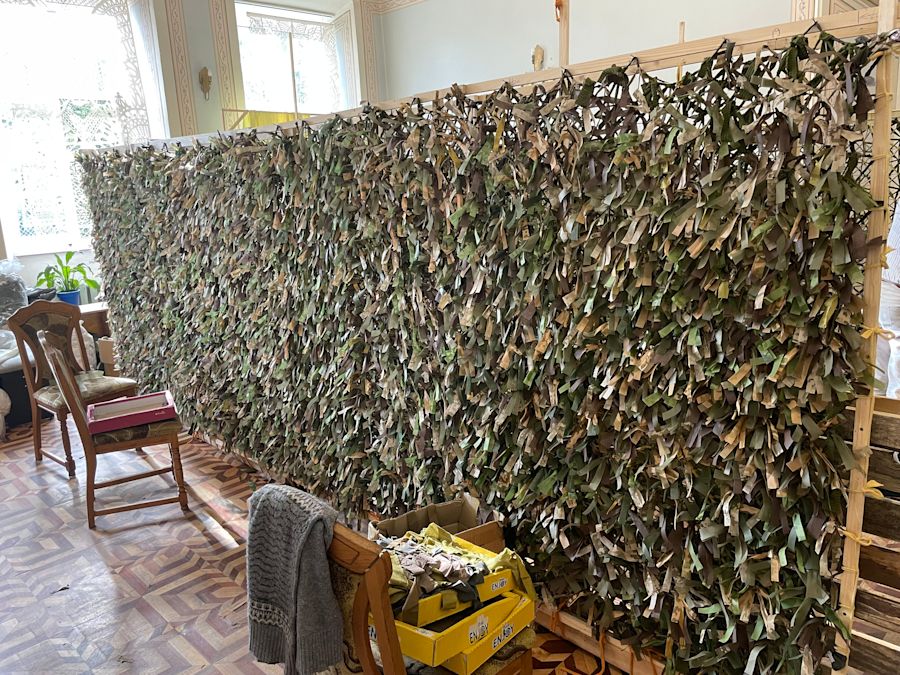
The atmosphere in the room that normally functions as a library is calm but always in a positive spirit. Music is audible from next door: One of the volunteers gives piano lessons; a small choir is singing while doing some needlework that is later sold to the benefit of the army. Almost every day, some volunteers bring a bit of food with them to share with the group – apples from their gardens, a piece of chocolate or self-made pastries. The longer we stay the more we find ways to talk to each other – despite the language barrier. The women are eager to understand why we came to Ukraine. They are deeply touched. It gives them a sense of reassurance that they are not alone and not forgotten.
We, in turn, ask them for their daily lives in Lviv. Almost all of them are domestic refugees. Their hometowns in the East and South are occupied or attacked by Russian forces. They tell us about their lives before the war and the beauty of their home regions – Zaporizhzhia, Donetsk or Cherson.
It is not our first stay. We came here in August 2022 and returned in February and August 2023. Never have we heard anyone mourn their situation – despite the hardships of the living conditions. Internally displaced persons receive 2,000 hryvnia every month, equal to no more than 50 euros. Even a tram ticket for a few cents is too expensive. Two of the volunteers, Oleksandra and Arkady, walk to the volunteer center for one and a half hours, one way, every day.
Volodymyr coordinates the volunteers. He is from Druzhkivka, a town between Kramatorsk and Bakhmut that used to have roughly 60,000 inhabitants. For a short while, Druzhkivka was occupied when Russia invaded the Donbas in 2014. Since the outbreak of the full-scale invasion, the town is the constant target of Russian shelling; it is completely destroyed. Before the war, Volodymyr ran a local bike club organizing tours through the nature and to landmarks of the local history. He is a great photographer. Whether he plans on returning to Druzhkivka, I ask him. Volodymyr’s eyes turn sad: “I have different thoughts every time someone asks me,” is his first reaction. After a break, he continues: “I want to see my mother’s grave. I could not be with her when she passed away… What else is left in Druzhkivka?! A few damaged bikes and my tools to repair them…” I don’t know what to respond. Thousands of domestic refugees in Lviv are on the fence – between relative safety in the city and the hope to return to a home that is not what it used to be.
How come we Europeans complain all the time about the tiniest aspects of our daily lives while Volodymyr and all the other volunteers have lost their homes and never mourn?!
Second stop: Kyiv
Ukraine’s capital Kyiv is the heart of the country, it is the intellectual and political center – as it has been for thousands of years. Kyiv, the metropolis on the Dnieper River, is magical. Historically, Kyiv had three city centers. In the upper town, not far from the Ministry of Foreign Affairs and the landmark St Andrew’s Church at the top of the Andriyivskyy Descent, was the center of the Kievan Rus’, an amalgam of principalities from the late 9th to the mid-13th century. The Church of the Tithes is symbolizing this first city center. In modern days, not only Ukraine but also Russia and Belarus consider the Kievan Rus’ their cultural ancestor. Russian President Vladimir Putin is frequently referring to this narrative when trying to justify his war of aggression claiming that Ukraine is an integral part of Russia.
After the Kievan Rus’ fell apart, Podil emerged into the city center of Kyiv. A trading town, Podil developed into a vibrant city with a high share of Jewish population. The German occupation during World War II and the holocaust as well as the discrimination of Jews during Soviet times destroyed almost all Jewish life Podil. Today, the neighborhood is the most exciting part of town with many bars and cafés home to Kyiv’s alternative scene. And it still hosts a wonderful synagogue.
Today’s city center is shaped by Soviet architecture. The stately buildings of Khreshchatyk street leave no doubt of Kyiv’s Soviet history. Kyiv’s subway resembles the metro of Moscow. However, these are just the architectural relicts. Kyiv’s subway, once built by the Soviets as a shelter to protect from a potential NATO attack, has turned into a shelter in Russia’s war of aggression against Ukraine. Maidan Nezalezhnosti, the Independence Square, has been the scene of two progressive protest movements. In 2005, the Orange Revolution successfully prevented election fraud and insisted that the elected President Viktor Yushchenko could take office. In 2014, the Euromaidan demanded the ratification of a fully negotiated association agreement with the European Union that pro-Russian President Viktor Yanukovich rejected. Only months after the Euromaidan succeeded and Yanukovich fled the country, Russia invaded Ukraine, the war began. Russia occupied Crimea and parts of the Donbas. In February 2022, the war broadened into the full-scale invasion. Putin never accepted the free will of the Ukrainian people as articulated in the two Maidan Movements.
Living with the war
Half a year into the full-scale invasion. Russian tanks are on Khreshchatyk street in the heart of Kyiv. No, Russian troops have not occupied the capital. Instead, Ukraine is showing weapons that its troops have captured from the invaders. On the outskirts of Kyiv, we visit places where the Ukrainians destroyed Russian military equipment and have not removed it from the scene yet. These places are widely referred to as “tank cemeteries”. Back in the city center, Kyiv’s residents are strolling around in the sun and watch the tanks, the artillery and the missiles. Children climb the destroyed Russian military equipment while their parents have a drink in one of the nearby bars or a tea in one of the cafés along Kyiv’s grand boulevard.
Captured Russian tanks on Khreshchatyk street, Kyiv (click to open)
Download
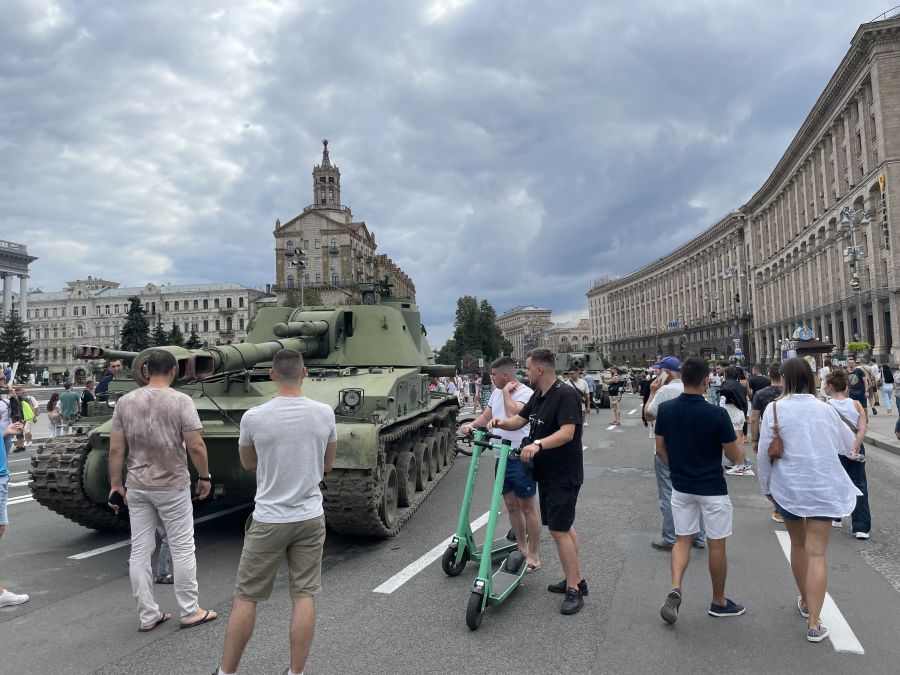
It is an awkward scenery for a foreigner to watch. The Russian weapons are put out of context and feature in an environment that looks like a sunny, peaceful afternoon in the heart of Kyiv. In front of the Foreign Ministry, we find yet another group of destroyed tanks. In front of one of them parks an electronic scooter like we use in Berlin and other cities in the West.
Tank and e-scooter in front of the Foreign Ministry (click to open)
Download
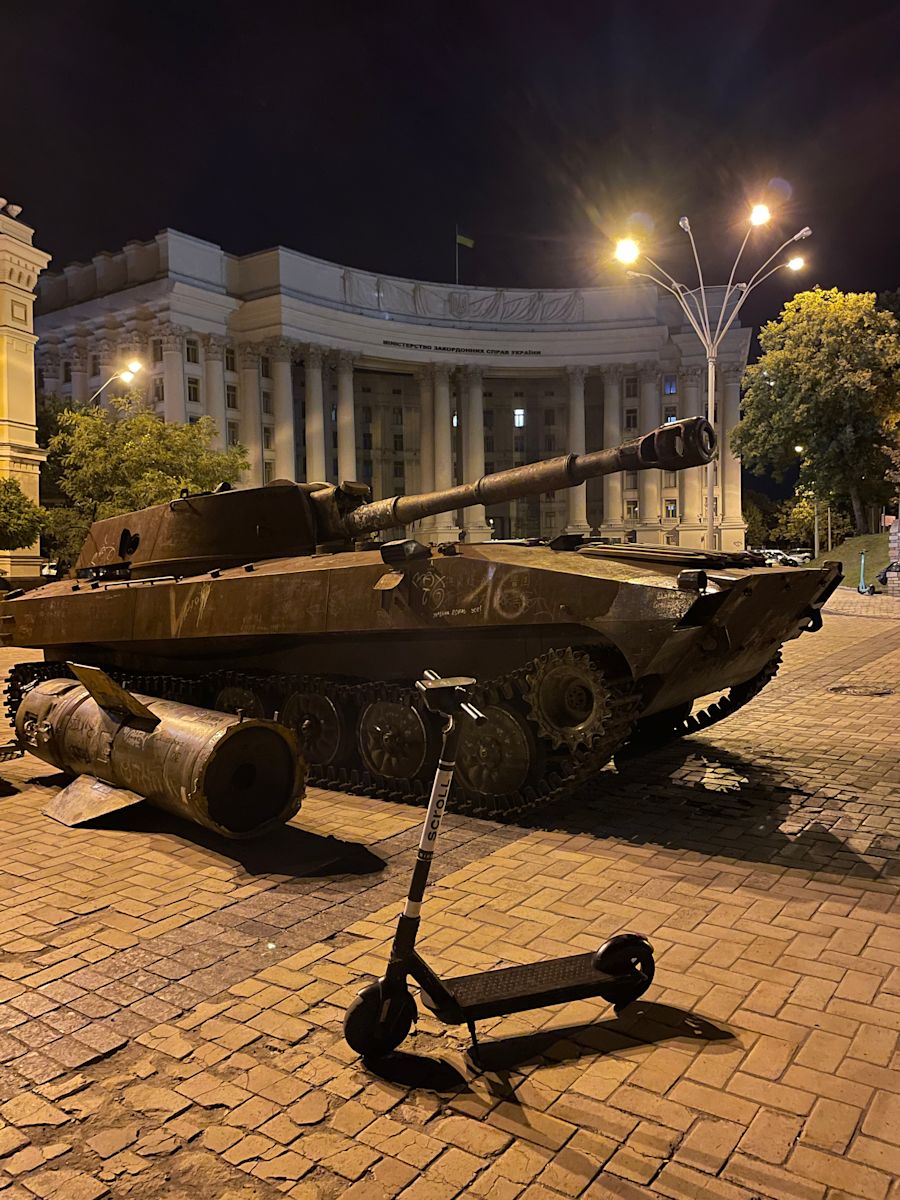
Apart from such symbolic places, life in Kyiv appears to continue as normal. The population goes to work. On Saturday mornings, large crowds flood the suburban trains on their way to the dachas just outside of Kyiv. The restaurants around the Golden Gate are filled. The bars and cafés in Podil welcome their visitors. Friday and Saturday nights are particularly busy – just like in times of peace. During the days, children play on the playgrounds of the city.
But the children carry toy guns and play war games. At ten o’clock, restaurants and bars start to empty because curfew kicks in at midnight and Kyiv is a big city where the way home can easily take one and a half or even two hours. Just a few meters away from the cafés, people stop at a blaze of small flags, each of which commemorates one solider, who has lost his or her life at the frontlines. The people of Kyiv have learned to live with the war; it is the perfect illusion of a normal life.
At Maidan Square, a blaze of small flags, each of which commemorates one solider, who has lost his or her life at the frontlines (click to open)
Download
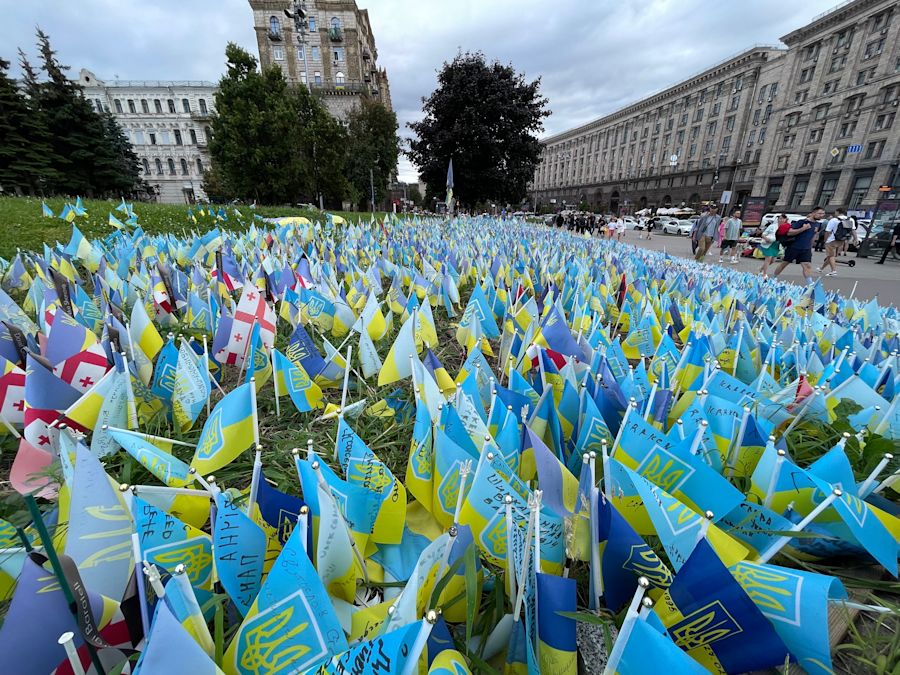
Several times a day, sirens howl through the city and on the smartphones – air raid alert. Nobody shows any sign of panic. People take out their phones, open Telegram channels to check for the reason of the air raid. If several MiG-31 jets have taken off from an airfield in Russia that could potentially reach Kyiv, life goes on as normal. Even if missiles or drones are reported to approach the city, people do not necessarily react. A notification of several Kinzhal hypersonic missiles on their way to Kyiv makes at least some people seek shelter. During the day, we follow the example of the Ukrainian people around us. During the night, I check my phone once the sirens interrupt our sleep. In Kyiv, the period between air raid alert and a hypersonic missile approaching is roughly ten minutes. The sound of the air defense is followed by what looks like contrails on the blue sky that mark the trajectory of the air defense missile.
Contrails on the blue sky mark the trajectory of the Ukrainian air defense missile (click to open)
Download
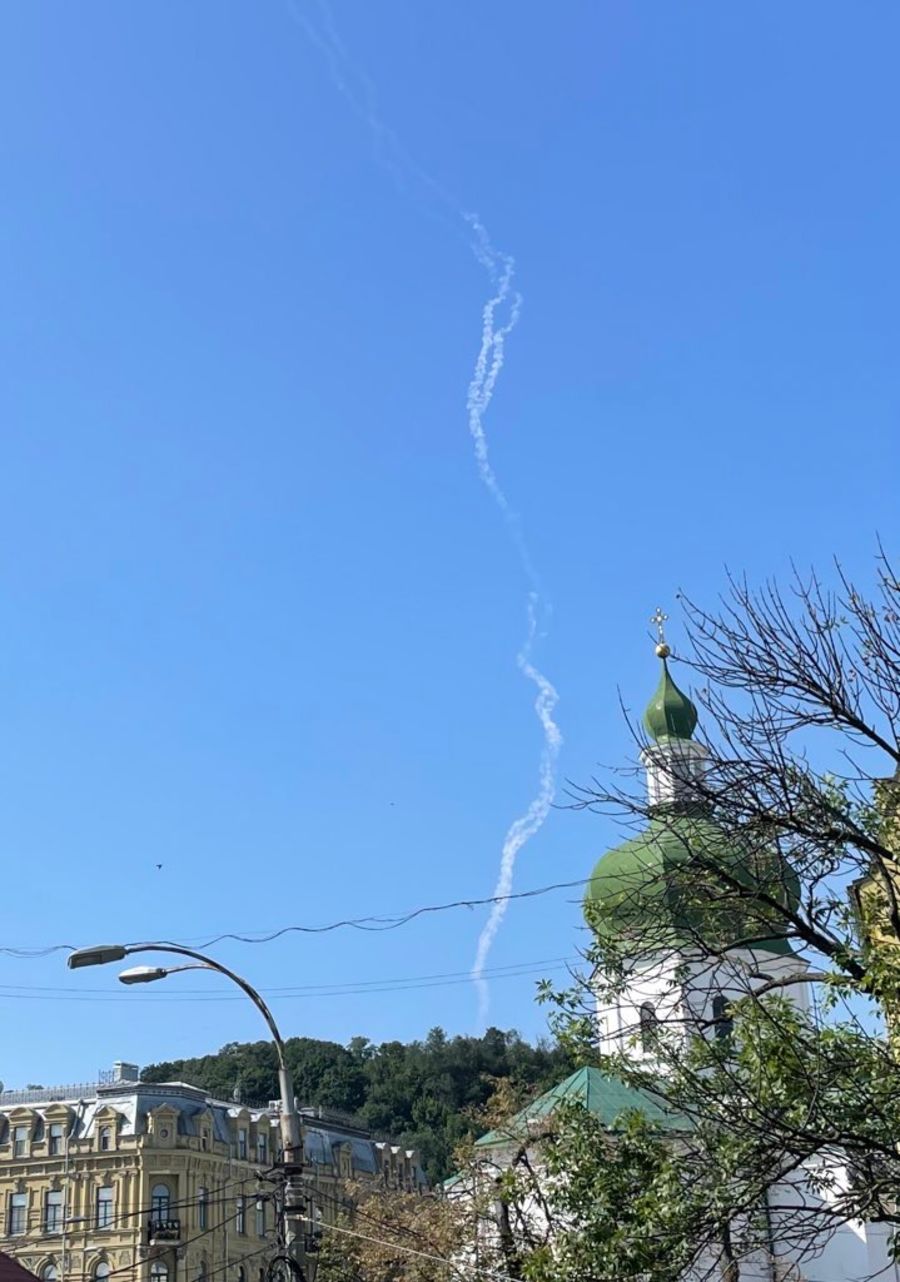
These practices of adaptation to the reality of war might seem surreal, but they are the only option to cope with the war. Those few people that seek shelter whenever the sirens howl are those that suffer the most from the war. The illusion of a regular life is essential to survive.
We are in Horenka, a suburb just outside Kyiv in the north of the capital. Horenka is not far from Bucha and Irpin. It was occupied by Russia in the early stages of the full-scale invasion. Horenka is a village with beautiful small, detached houses and gardens. Bullet holes prove that Russian forces shot on each and every civilian house. Many private homes are fully destroyed. We go to Horenka with a group of volunteers to clear the debris from destroyed houses.
Private house in Horenka (click to open)
Download
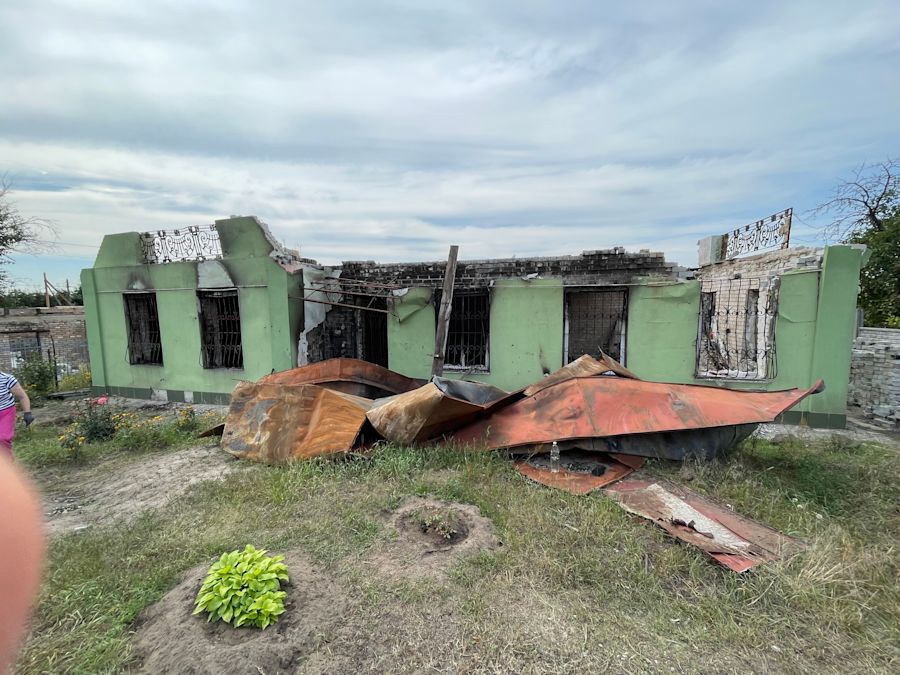
The remains of the household in Horenka (click to open)
Download
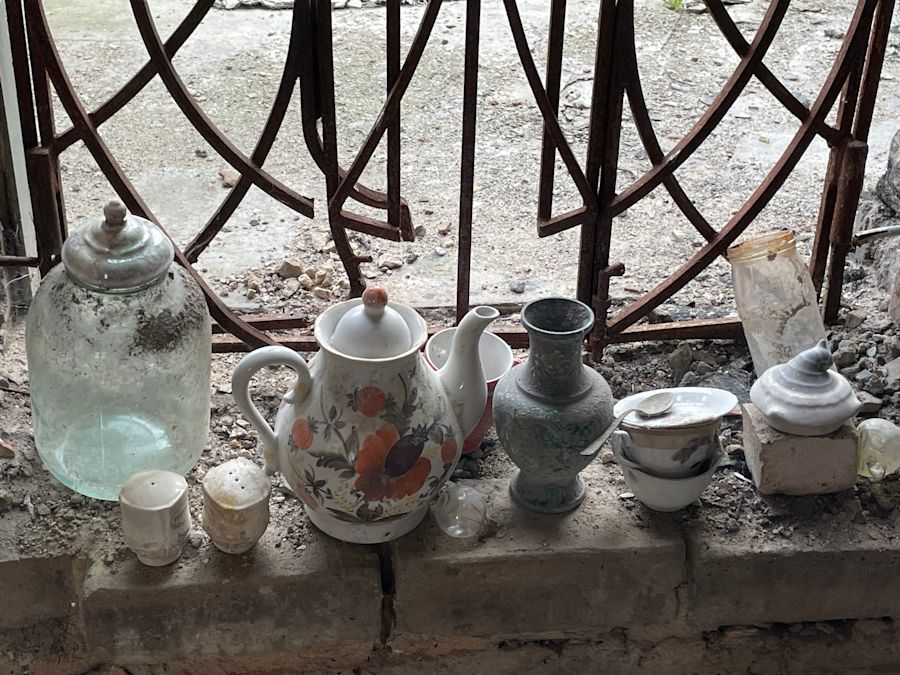
Shards and debris - Russian forces destroyed private homes in Horenka (click to open)
Download
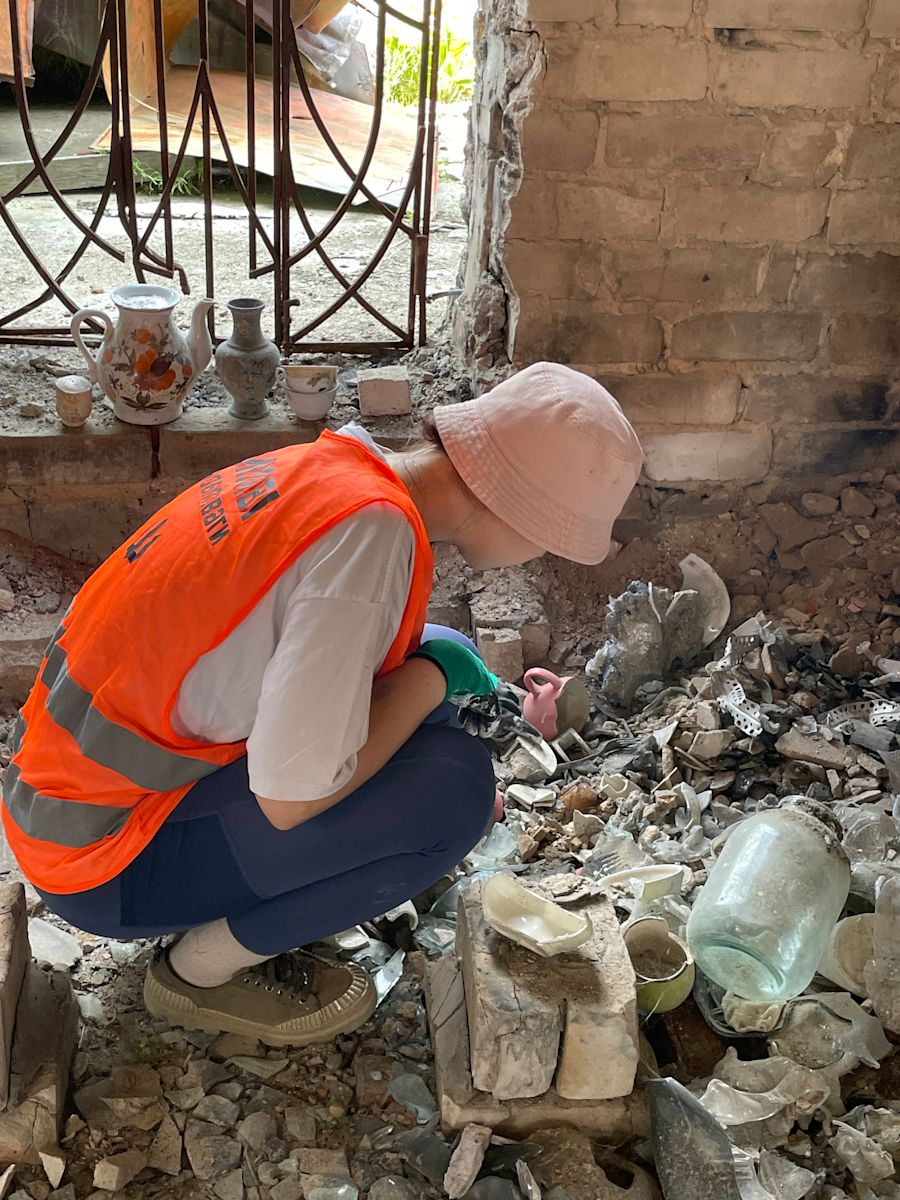
At lunch, the owner of the house is serving some food. I chat with a young woman, let’s call her Anna. Her face shows remarkable physiognomic similarities to an old friend of mine from Sweden, and both share a similar way of smiling. I cannot believe it when I learn that she has the same first name as my Swedish friend. At first, we talk about Anna’s job in financial sales. She dislikes her profession. Anna is eager to travel but has not had the chance yet to go abroad. She dreams of a trip to Germany – not least because of the beer. She tells me that she is from Zaporizhzhia, which the world has gotten to know as the site of Europe’s largest nuclear plant occupied by Russia. But Zaporizhzhia is also a beer region. “Is your family still in Zaporizhzhia?”, I ask her. “Yes,” she replies. “Just last week, my brother went to the convenience store. Half an hour later, the store was hit by a missile. That’s why I do not care about the sirens anymore. If I am supposed to die, I will and if not, I will not.” I am speechless. She speaks about the missile attacks as a normal phenomenon that is beyond our control and without any emotion in her voice. “I am so sorry…”, I say with a hoarse voice and feel the desire to hug her. But before I can do, she simply shrugs her shoulders: “Don’t be shocked. This is our life now.”
I understand that not only does she protect herself from her, but also from my emotions. It is the only viable way to cope with the war.
“We do not have machines, we have hands”
Ukraine’s ability to resist the Russian invasion has surprised many observers and intelligence services – with the notable exception of the Polish secret service. The reasons are multiple including Ukrainians’ commitment and bravery, weapon deliveries and Russian mistakes. Seldom mentioned in this context is the remarkable ability of Ukraine to skillfully combine high and low tech. Whenever the need to train Ukrainians is considered a challenge for the delivery of new and advanced weaponry, you can confidently cut the estimated time of training in half if not more. Time and again, Ukraine’s soldiers surprise their Western counterparts on how quickly they learn and adapt to high technology.
At the other end of the spectrum, Ukraine is skillfully using low tech goods that are often produced by volunteers. The most well-known case are cheap, low-tech drones that remain unseen by Russian radar systems and make it all the way into Russia – often to Moscow region – and take the war back to the homeland of the aggressor. Another example is that Ukrainian soldiers receive only two uniforms per year. At the frontlines, in the middle of war, two uniforms are not enough. As the Ukrainian state is in a mode of reconstruction and under constant threat, Ukrainian volunteers produce uniforms for the armed forces. We join a volunteer center in a cellar below yet another library in a suburb of Kyiv producing camouflage clothing for snipers.
Volunteer center in Kyiv: In a cellar, camouflage nets and clothing are produced (click to open)
Download

Throughout the country, volunteers weave camouflage nets to cover military posts and equipment. Every volunteer center has its own technique and communicates directly with military units. No central coordination is necessary; the direct communication ensures that the nets exactly fit its purpose on the ground – in terms of coloring, size etc. – and it is a vital link between the frontlines and the society in the hinterland.
This house will need to be teared down by volunteers. Horenka, Kyiv Oblast (click to open)
Download
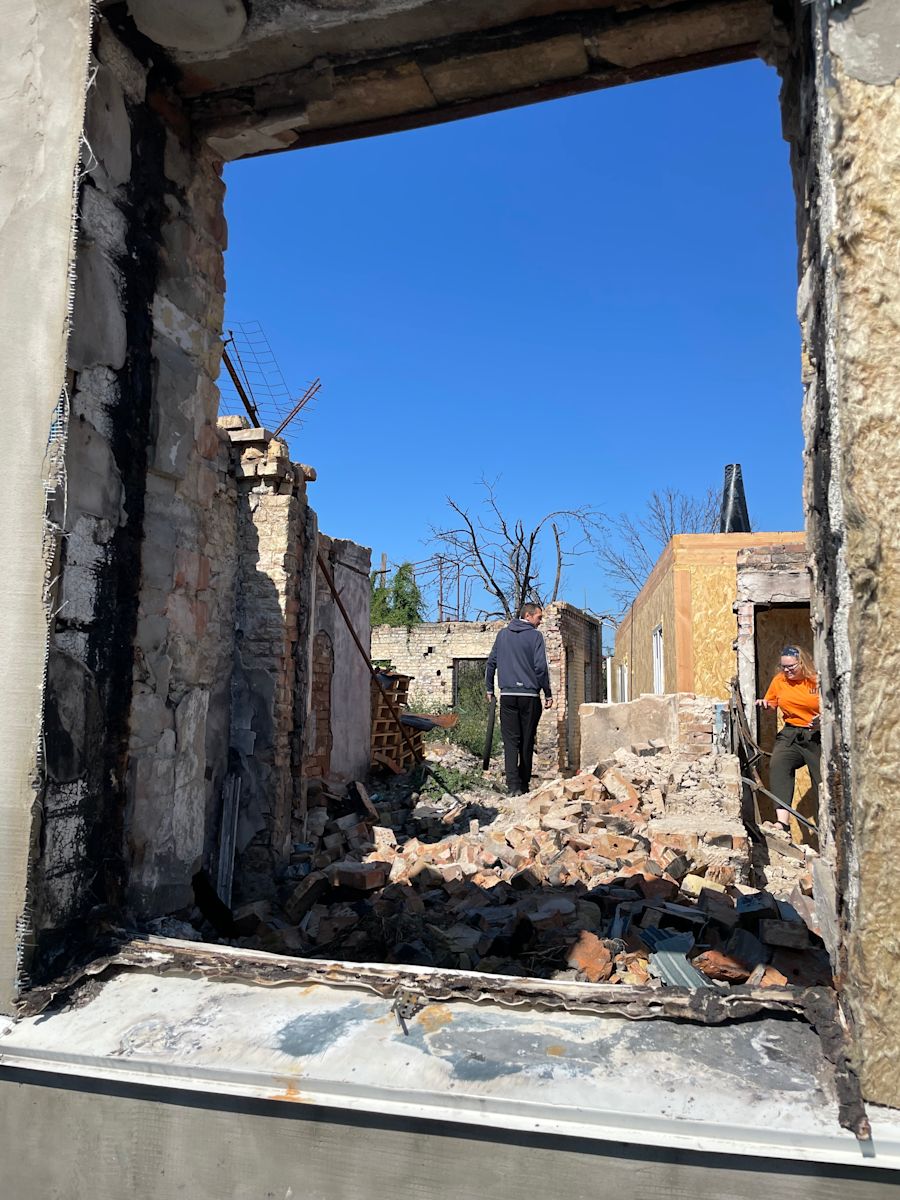
Ukraine’s reliance on manual work is also well-captured by an episode in yet another private house in Horenka that we clear. After a full day of loading debris on a truck, we speak with the coordinator of the volunteer group. Standing in front of the ruins of the house, we ask whether our work was useful. Once all the dust is loaded onto a truck, the remnants of the house surely need to be taken down and then, new volunteers need to carry away more debris, we argue. “The house owner will only get compensation from the state after the remaining walls are being documented,” she replies. “So, we cannot take down the walls now.” – “But why don’t you wait until everything is taken down and then you can bring an excavator here?”, we ask. She laughs: “I understand your question. But we do not have many excavators in Ukraine right now. Volunteers take out the debris by hand. Volunteers will tear down the remaining walls with their hands and will carry away the new debris. In Ukraine, we do not have machines, we have hands.” And this is not only the case for private houses. In Bucha, we help renovating a classroom of a destroyed public middle school.
Renovation work in a public school in Bucha (click to open)
Download
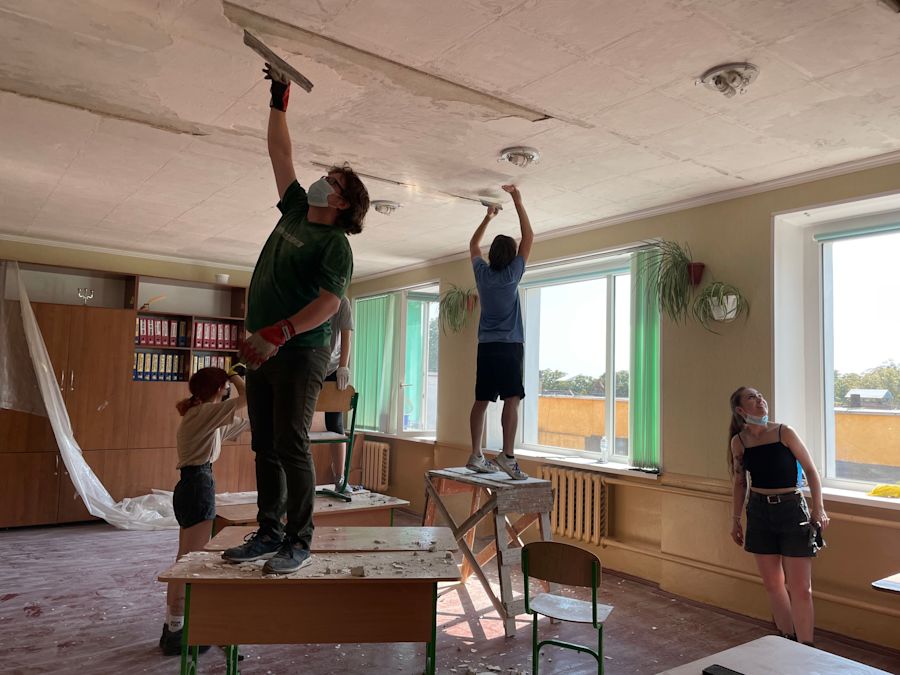
A few days later, we have a similar experience in another context. In a volunteer center in the heart of Kyiv, we are given small pieces of jute that are cut out from jute bags. In the coming hours we unweave the jute strings so that they can be reused for the production of camouflage clothing.
All this illustrates that volunteering in Ukraine is far more than just an act of goodwill with marginal effects. The Ukrainian state is overburdened, and volunteering is of paramount importance for the functioning of the society. Nobody asks for the state, everyone simply fills in where help is needed.
Third stop: Kharkiv
Kharkiv, Ukraine’s second largest city, is just 40 kilometers from the Russian border. Russian troops never occupied the city. This is remarkable not only because of the geographical proximity. Traditionally, Kharkiv is one of Ukraine’s most euro-sceptic cities. In 2014, only a few hundred protestors visibly supported the Euromaidan movement that took place in Kyiv at the same time.
But Kharkiv was never Russia-friendly. Instead, the city carries a strong local identity. In 2014, a few pro-Russian political forces proclaimed the “Kharkiv People’s Republic”. But unlike in Donetsk and Luhansk, this separatist coup failed within two days. In the same year, pro-Russian President Yanukovich’s attempt to assemble his supporters in Kharkiv met large-scale demonstrations calling for the unity of Ukraine. In the following, terrorist attacks of pro-Russian activists further alienated the local population from Russia.
Nonetheless, in a public opinion poll in 2018, a majority of citizens favored a neutral positioning of Ukraine. One quarter attributed the responsibility of the war in the Donbas to Russia; the same share of respondents blamed Ukraine.
A city shaped by war
A late-summer evening. Our train approaches Kharkiv when a young woman with her daughter addresses us in German. They have found refuge in Bavaria, Kharkiv is their hometown. The woman’s parents eagerly await her on the platform. We ask whether she and her daughter are just visiting or planning to remain in Kharkiv. “Just visiting,” she replies. “It is still dangerous here; the warzone is not far away.” We leave the train station and are welcomed by a city in darkness. The streetlight is switched off. We catch the last subway that stops operating as early as 9:30 PM before curfew begins. Shortly after we arrive in our apartment, sirens indicate the next air raid. In Kyiv, we had ten minutes to check Telegram and Signal channels to decide whether we seek refuge in a shelter. In Kharkiv, this period is down to 45 seconds. This is how long it takes for a supersonic missile from Russia to the city.
One night, the city is already under curfew, the streets are empty and calm, the sirens indicate air raid. Two Shahed kamikaze drones are reported in Kharkiv Oblast approaching the city. We are at home, cooking dinner, when we hear the sound of a motor outside: One of the drones has escaped the air defense and is above the city not far from our house. We are relieved when noticing the drone got shut down south of Kharkiv after passing our house. For Kharkiv’s citizens, such incidents are part of their normal life.
In the morning, we leave our apartment for a field kitchen in which we volunteer. The streets are empty. Before the war, the city hosted 1.5 million inhabitants. Nobody knows precisely how many people are still here. Locals estimate that two-thirds have left. The city is calm. When we think of war, we associate it with shelling and explosions. At this moment, here in Kharkiv, the sound of war is silence.
Kharkiv - an "empty city". Svobody Square, August 2023 (click to open)
Download
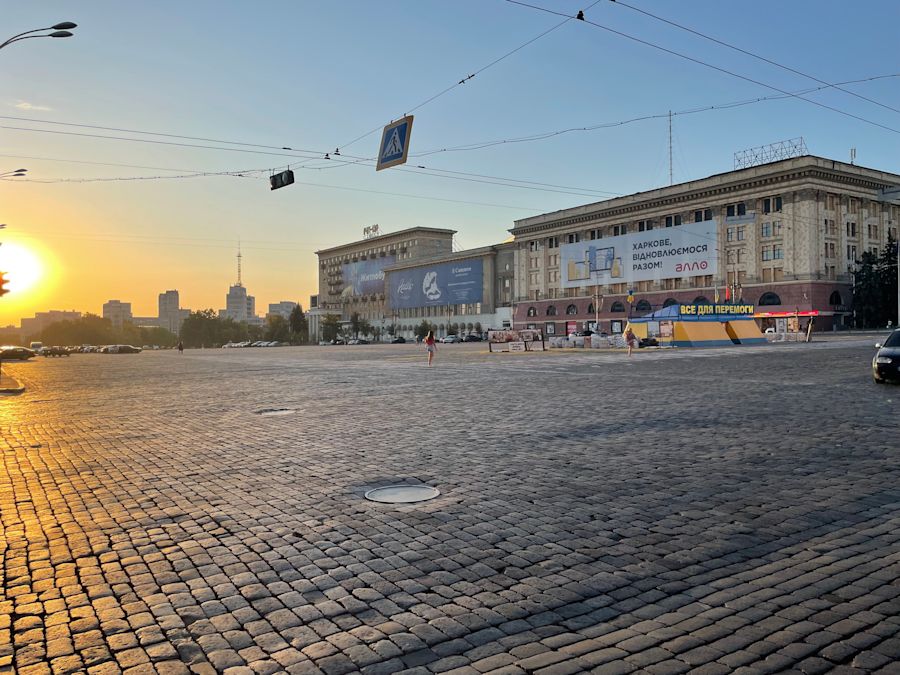
This has not always been the case. We visit Saltivka, a neighborhood in the northeast of Kharkiv, home to around 500,000 inhabitants before the full-scale invasion. Under attack for several months, the signs of shelling are omnipresent in Saltivka. Not a single of the prefabricated blocks that we pass has remained undamaged. Broken windows are replaced by pressboards. Missile splinters have left visible holes in the facades of the buildings. And black soot is the result of apartments that have burnt out completely. Traces of Russian shelling are visible on the walkways.
Residential building in the city center of Kharkiv after a Russian missile attack (click to open)
Download
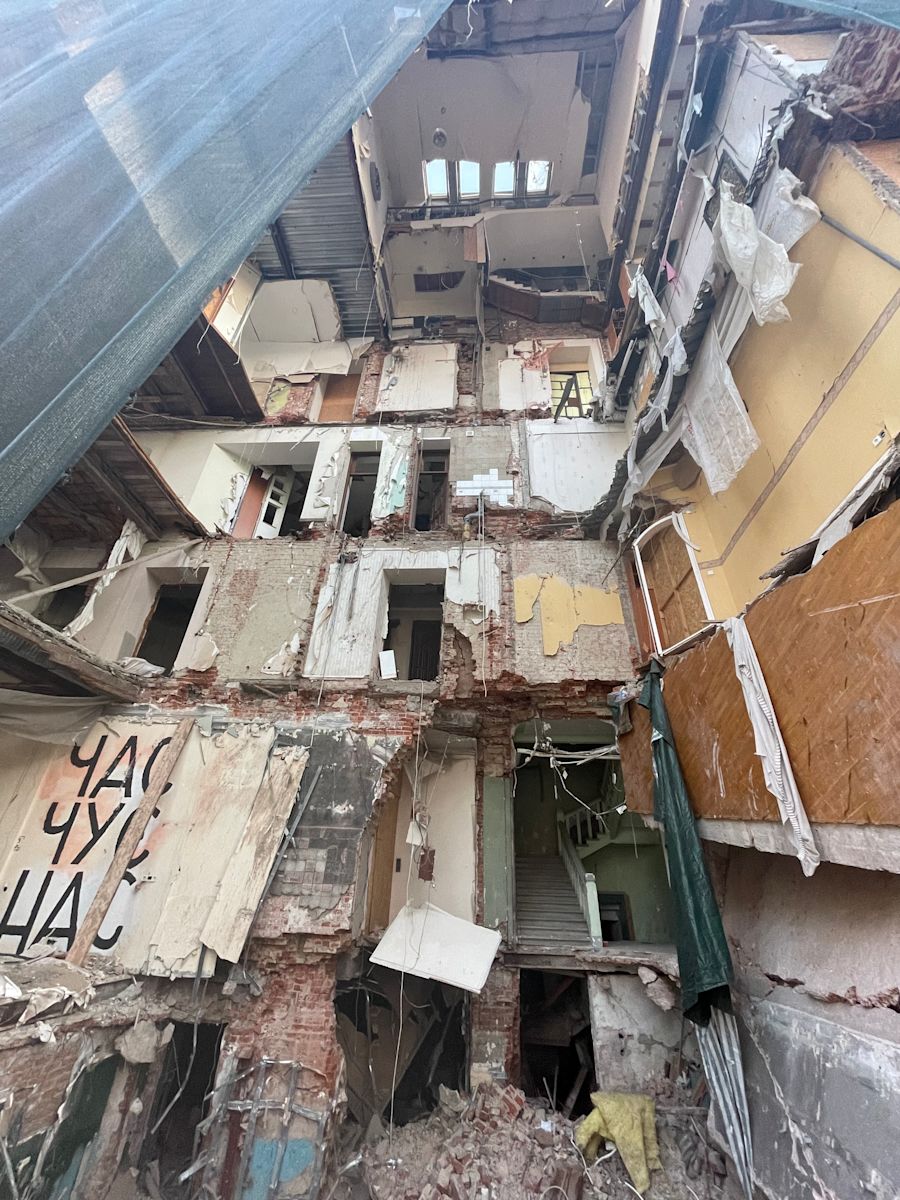
Back in the city center, we pass several residential buildings that have been hit by missiles. The attacks have exposed private apartments and staircases to the eyes of pedestrians on the street. Nobody takes notice. Kharkiv’s citizens got used to the relics of Russian shelling. Svobody, Kharkiv’s main square, has also been hit by a Russian missile. The adjacent university and administrative buildings are damaged – so is a McDonald’s branch. South of the main square, a statue commemorates the children of Kharkiv that have fallen victim to Russian aggression: Two angles strive heavenwards holding a teddy bear. Parents and friends have laid down cuddly toys for their beloved ones murdered by Russian shelling.
Statue commemorating the children of Kharkiv that were killed by the Russian invasion (click to open)
Download
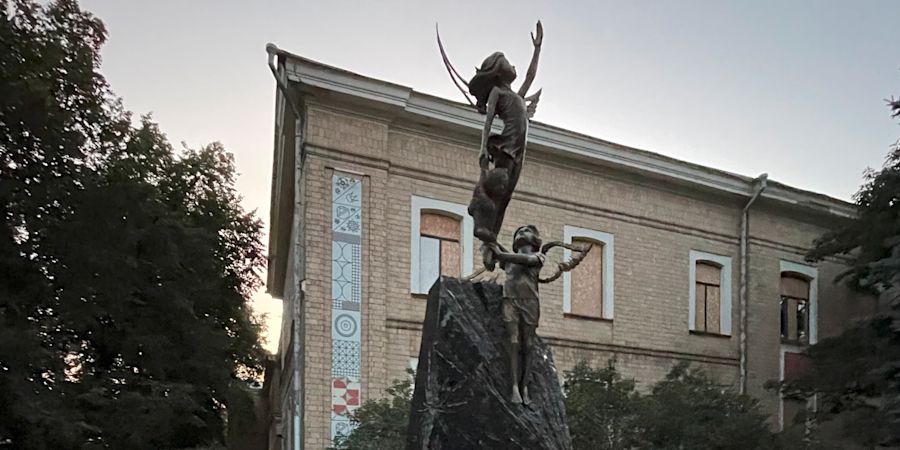
On the southeastern outskirts of Kharkiv, we visit Drobytsky Yar. In 1941, German forces occupied Kharkiv and incarcerated its Jewish population in a tractor factory. Over the coming months until spring 1942, SS troops murdered at least 16,000 Jews at Drobytsky Yar. To approach the site, we pass a roadblock by foot. The street on which we are heading out of town leads to the frontlines. We reach the monument commemorating Drobytsky Yar – it has been damaged by Russian shelling. Not even the commemoration of the holocaust is spared from the fighting.
The memorial of Drobytsky Yar - damaged by Russian shelling (click to open)
Download
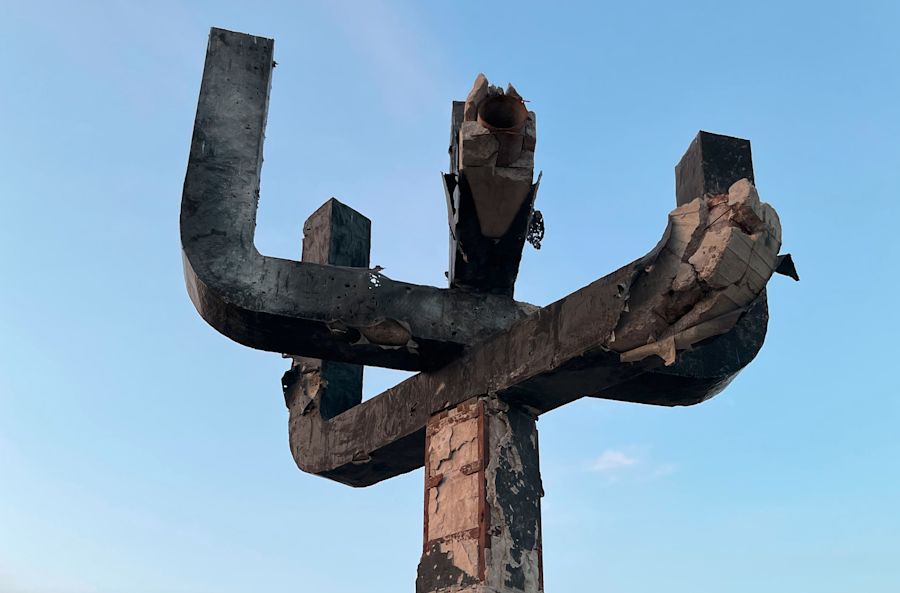
No doubt, Kharkiv is a city shaped by war. It is deeply wounded, but also quick in adapting. Houses and infrastructure are temporarily repaired. Kharkiv might be emptied out, but it is a fully functioning city. We meet Yosyp. He is sixteen years old and about to finish high school. When recalling the beginning of the full-scale invasion his description is as sober as Anna’s statement above: “I was in Kharkiv and woke up around 5 o’clock. The sky was orange from the MLRS Grad missiles fired by the Russians on northern and eastern parts of the city and the constant sound of explosions. It was scary but I wasn’t shocked. My mom was very nervous; my dad was more or less okay. My little brother didn’t know anything about war at that time. He was only eight years old; I was 14. The first thing I did was calmly get up, take the tablet and open the news channels in Telegram. It was 5:00 AM. In the first two minutes I could not find anything, then thousands of messages poured in.”
Yosyp’s home has no shelter. To be as protected as possible, Yosyp’s family spent a lot of time in the central room of the apartment furthest away from the windows and the outer walls, for the first few months. One day, Russian tanks rolled through his street. His parents sent Yosyp and his brother with friends to stay in the Lviv region in the West of Ukraine. I ask whether he wanted to return to Kharkiv. “Yes, because Kharkiv is a very big city,” he replies. “In the town in the Lviv region, they don’t have a cinema, they do not have a lot of parks. You can only read books from the library or drink. I prefer books.” In Kharkiv, cinemas are up and running. Whoever might be surprised of the continuation of normal life in a city shaped by war does not know the spirit of resistance – it is the spirit of Kharkiv.
The city of heroes
The reasons for Russia’s failure to occupy Kharkiv are multifold: Some of Ukraine’s most capable brigades were stationed in the city when the full-scale invasion began. Russia underestimated the resistance and sent ill-equipped troops to the region. Apparently, the occupiers anticipated that the aggression would meet significant support in the city. Kharkiv’s mostly Russian-speaking population has close personal and economic ties to Russia.
But the local population organized itself in resistance to the occupiers. The civil society is a key to defending the city. On Svobody Square, a large poster reads: “Kharkiv – city of heroes!” Granted, most people fled the city. A significant share of those who stayed are elderly and disabled that cannot leave easily. But both soldiers and those in need could always count on Kharkiv’s impressive civic tradition of self-help to survive, to resist and to preserve freedom.
Kharkiv - city of heroes. Sign at Svobody Square (click to open)
Download
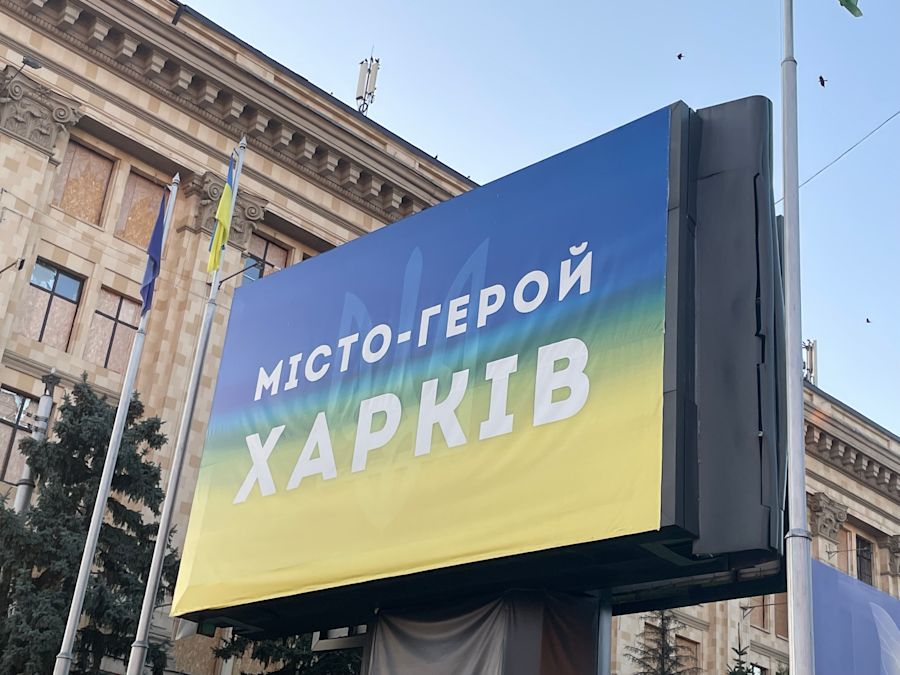
Already in 2014, 300,000-380,000 refugees from the Donbas came to Kharkiv. In all parts of town, volunteering initiatives emerged to support the refugees. In 2017, two thirds of the newly arrived indicated that they felt “fully integrated” into the local society. Apparently, Kharkiv’s civil society fulfills functions that are normally attributed to state authorities.
To understand why Ukrainians are ready to support, one needs to consider the country’s Soviet past. We meet Larysa, the woman quoted at the very beginning of this piece, and her husband Oleksiy. The couple initiated the field kitchen that we work at only one day after the full-scale invasion began. One and a half years later, both still devote all their time to the volunteer center and live from their savings. “Many laws are from Soviet times,” Oleksiy explains when we ask him for the roots of civic engagement. “These laws are not intended to support the society, make our lives better and more convenient, but to control and manipulate us. For many people, the state is something completely separate from them. We are still in the process of considering the state as part of our society and our life.” This mindset makes Ukrainians take responsibility for their society: “We should not ask who is to be blamed, but what is the problem and how can we help? For example, when we see that we have a lack of functioning drones, we do not blame the government. Instead, we simply set up a school to teach soldiers how to repair drones. We know that we cannot do everything ourselves, but we should contribute whatever we can.”
A field kitchen in Kharkiv (click to open)
Download
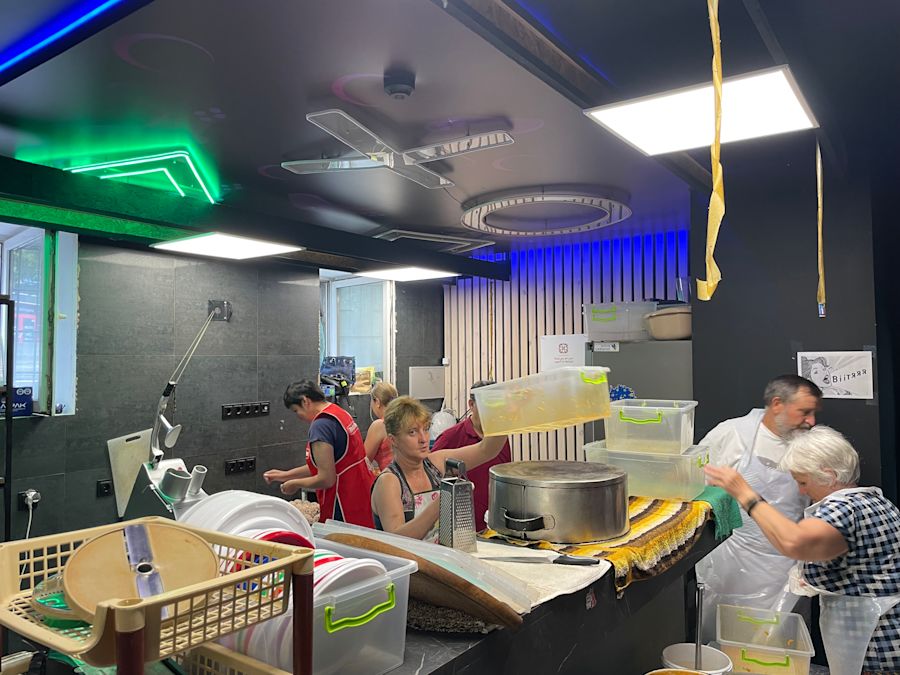
These are not empty words. At the moment, around 70 volunteers work with Larysa and Oleksiy – most of them parttime. In a cellar, 1,000 meals are cooked, and 1,300 rolls baked on a daily basis. The kitchen area is remarkably small with simple amenities. The food is of high quality. Half of the meals are sent to soldiers; the other half is delivered to hospitals in Kharkiv that treat both soldiers and civilians. Some volunteers develop a demining machine in a separate room, and soldiers are trained to repair drones. Soldiers contact the center directly whenever they need something special. On a sunny afternoon, we load food into a van with snipers. We shortly hug one another before they go out to the frontlines again. In only a few hours, these people risk their lives to defend our freedom.
Snipers picking up food for the frontlines (click to open)
Download
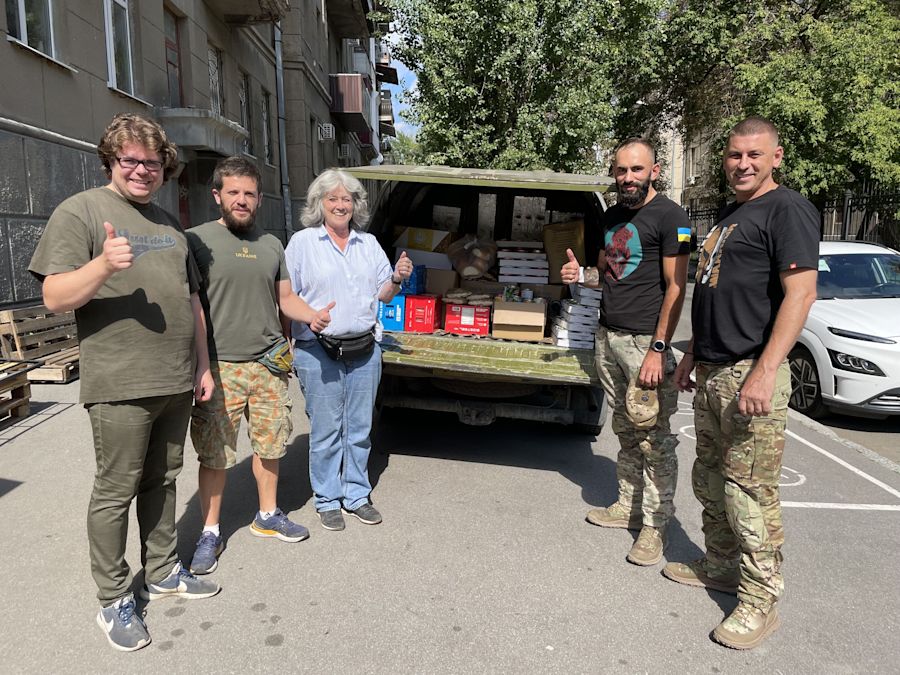
Commitment and dedication can be found everywhere in the region. During the first days of the full-scale invasion when food was unavailable in Kharkiv, Larysa and Oleksiy drove to a small town near Poltava. Despite the uncertainty and risk of a Russian advancement towards Poltava, ordinary people donated groceries from their homes to the volunteer kitchen in Kharkiv. Larysa and Oleksiy recall: “This was very touching. People donated whatever they had, and we just pulled it into our car. We were grateful for a half bottle of oil or a bread.”
It is hard to imagine, under which conditions Larysa and Oleksiy set up the kitchen. Larysa’s quote in the very beginning of this article illustrates the chaos from which the initiative emerged. “I do not believe that anyone can be prepared for a war,” Larysa tells us. “It’s totally different whether you hear about death, shooting and shelling or if you find yourself in this situation. When the war began, our soldiers appeared in the trenches on the streets of Kharkiv. At that moment, the majority of Kharkiv’s population left the city. There was no work anymore, nothing. Shops closed. There was no light in the city. It was extremely difficult to find a place to hide and where you could eat properly. In this horrible and scary situation, many people started to organize themselves in volunteer groups. We were ready to help. There was such a lot to do and there continues to be. Volunteers were quick to step in.”
The field kitchen has its own bakery (click to open)
Download
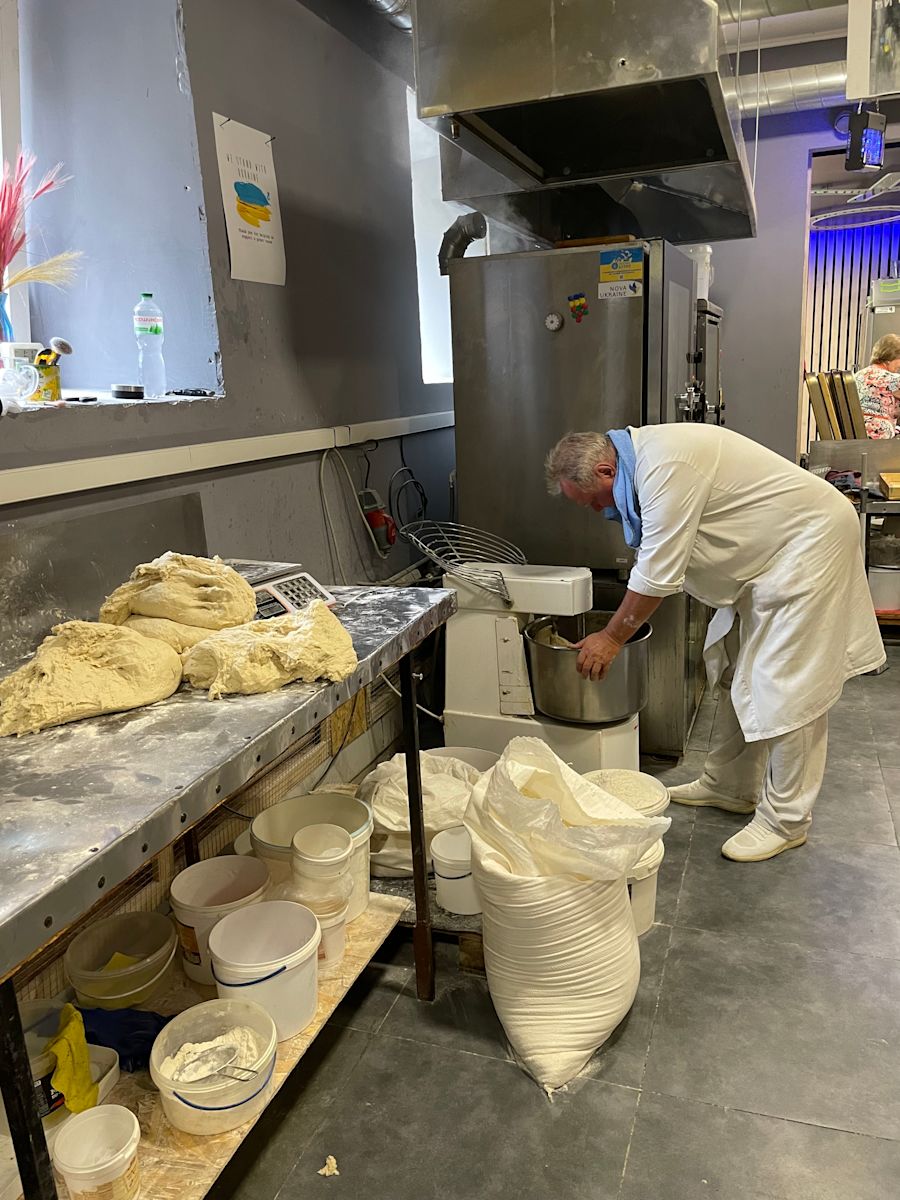
We are full of admiration for what Larysa, Oleksiy and all the other volunteers have done and continue to do every day. Kharkiv is truly a city of heroes.
This is our war: what can we as foreigners do?
The most frequent question Ukrainians ask me is: “Why have you come to a country at war?” I have no relatives in the country and no deep personal ties. Before the full-scale invasion, I had visited Kyiv only once in 2014. The reason for my support is simple: This war is not primarily about Ukraine; it is about Europe and whether the rules that have pacified the continent persist. Vladimir Putin and his supporters do not respect the will of the free people of Ukraine as expressed in democratic elections and at Maidan Nezalezhnosti, the Independence Square of Kyiv, in 2005 and 2014.
Granted, Russia’s war of aggression is not the first and only time that the self-determination of sovereign nations is ignored. For two reasons, however, the war in Ukraine stands out for me and for us Europeans: geographical proximity and potential consequences for the rest of Europe. It may or may not be ethical, but the feeling of compassion tends to be stronger when injustice and suffering are happening in front of our own eyes. Kyiv is just two flight hours away from Berlin. From the first day of the full-scale invasion, thousands of refugees arrived in Berlin. Whether I am in the subway to work or in a bar for an afterwork drink, I hear Ukrainian in Berlin. The war is not abstract and far away – it is just in front of my door.
Similarly, the outcome of the war will affect Europe directly. If Russia wins Putin might decide to attack Moldova, Latvia, Lithuania and Estonia next. The latter three are members of the European Union and NATO. We would be at war with Russia. If the Kremlin ignored Poland’s sovereignty the front could come as close as 90 kilometers to Berlin. This is the distance from Kharkiv to the frontlines. All this may be speculation. But the lesson Russia’s war of aggression has taught us is that we need to carefully consider risks even if we think they are unlikely. War is back in Europe; the unthinkable has become reality.
In this situation, I do not want to sit at home and passively watch tv as if the war in Ukraine would be yet another piece of news like all others. Therefore, we bought a train ticket and went to Ukraine – no preplanning, no organization. My contribution is small and not decisive, I know that. But I feel that I can encourage Ukrainians and that what I do is useful, even if only a tiny contribution.
If you feel the same way and want to get active, don’t hesitate and reach out to me. There are plenty of ways to support Ukraine:
You can consider volunteering yourself in Ukraine. Yes, it poses a risk, and I would never try to convince anyone taking it. If you feel you might be able to cope and rationalize the risk but have questions, just get in touch.
You can inform yourself and pressure our political leaders to increase military and humanitarian support for Ukraine. I am happy to help you identify ways to get information beyond what you can find in mass media that helps you understand the situation on the ground and what kind of support is needed from us.
And, of course, you can donate – for military or humanitarian purposes. If you are concerned how much of your donation trickles away in large bureaucracies of international NGOs, then donate to the volunteer initiatives in Ukraine directly. Every penny and every cent will make a difference. Don’t hesitate to get in touch if you want me to help find a local volunteer organization that you can support.
The outcome of this war depends not only on politicians, but also on ordinary citizens. I deeply admire the courage of the Ukrainian people. Now, it is our turn. Let’s get engaged!
